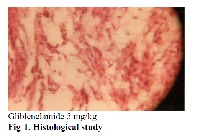Pharmacognostic and antidiabetic study of Clitoria ternatea
Keywords:
Diabetes, hypoglycemic activity, chronicle administration, indigenous herbAbstract
Aparajita means "The Undefeated". This plant is a trailing creeper with the usual Indigo Blue colour flowers and the rare white ones which is more of a pale cream with a hint of green at the edges. In Kerala it is called the Sankhu Pushpam or Conch Shell flower although it hardly resembles a Conch shell. It actually resembles a quaint Snapdragon flower with it's front open. Graphically it represents the cutout of an inverted womb. May be that explains their close affinity to Indian Midwives, particularly the White variety. Aparajita grows throughout India. It is a beautiful-looking plant, hence cultivated in gardens. It is a perennial twining herb having 7 leaflets, which are elliptic and obtuse. There are few varieties with white, violet and blue flowers. The pods are 5-7 cm long, flat with 6 to 10 seed, in each pod. The flowers resemble in shape to cows ear, hence the synonym- gokarnika. Chronic administration of plant extracts (100mg/kg) for 14 days reduces the blood glucose level of the diabetes induced animals as compared to diabetic control group. There was significant decrease in the blood glucose level in the 7th [p<0.01] and 14th [p<0.001] days of the diabetes induction, showing antidiabetic effect. The effect was comparable to that of standard antidiabetic drug Glibenclamide. The aim of this research is to explore the antidiabetic activity of this plant which will be helpful in the future investigations.
References
Chopra RN, Nayar SL, Chopra IC. Glossary
of Indian Medicinal Plants, (CSIR, New
Delhi), 1956.
Ivorra MD, Paya M, Villar A. A review of
natural products and plants as potential
antidiabetic drugs. J Ethnopharmacol. 1989;
: 243
Tiwari AK, Rao M. Diabetes mellitus and
multiple therapeutic approaches of
phytochemicals: present status and future
prospects. J. Current Science. 2002; 83 (1):
Rahman AU, Zaman K. Medicinal plants
with hypoglycemic activity. J
Ethnopharmacol. 1989; 26 (2): 1
Lin CC. Crude drugs used for the treatment
of diabetes mellitus in Taiwan. Am J Clin
Med. 1992;.20: 269
Mahabir D, Gulliford MC. Use of medicinal
plants for diabetes in Trinidad and Tobago.
Rev Panam Salud Publica. 1997; 1:174
Ziyyat A, Legssyer A, Mekhfi H.
Phytotherapy of hypertension and diabetes
in oriental Morocco. J Ethnopharmacol.
; 58: 45
Mukerjee SK, Mukherjee S. Therapeutic
advances in diabetes mellitus through ages.
J Rev Indian Med. 1966;1: 9
Chaudhary RR, Udupa KN, Chaturvedi GN,
Tripathi SN, Vohora SB. Plants with
possible hypoglycemic activity in advances
in Research in Indian Medicine, Banaras
Hindu University, Varanasi (India), 1970;
Karnick CR. Some aspects of crude Indian
drugs plants used in Ayurvedic system of
medicine (Madhumeha). Acta Phytother
Amst. 1972; 19: 141
Satavati GV, Raina MK, Sharma M.
Medicinal Plants of India, Vol 1, (Indian
Council of Medical Research) 1976.
Satyavati GV, Gupta AK, Tandon N.
Medicinal Plants of India, Vol 2, (Indian
Council of Medical Research, New Delhi)
Villegas R., Gao Y, Shu X. Legume and
soy food intake and the incidence of type 2
diabetes in the Shanghai Women’s Health
Study. Am. J. Clin. Nutrition, 2008; 87:
-167
Villegas R., Vegetable but not fruit
consumption reduces the risk of type 2
diabetes in Chinese women. J. Nutrition,
: 2008; 574- 580.
Snedeeor GWWG. Cochran in “Statistical
Methods”. Oxford and IBH Publishing Co.,
New Delhi, (1967). 33
Dhawan D, Bandhu HK, Singh A, Nagpal.
Indian J. Pharmacol. 1996; 28,224
Sharma SR, Dwivedi SK, Swarup D.
Journal of Ethnopharmacology 1997; 58,
-4



